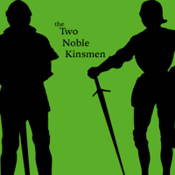
Explore this Show
Overview
Synopsis
Brave and noble cousins, Palamon and Arcite, are taken prisoner after a bitter battle between Athens and Thebes. The men resign themselves to their fate as happy captives - until they catch sight of Duke Theseus' beautiful daughter Emilia and both immediately fall in love. Their life-long friendship is soon marred by rivalry over Emilia’s affections - a thing made more complicated by the fact that Emilia doesn’t really want either of them. Meanwhile, the daughter of the jailer has fallen for Palamon, and will go to any lengths to help him and win his love.
This story of a classic love triangle is based on Chaucer’s Canterbury Tales, with some notable additions and deviations. This fast-paced tragi-comical romance uses the action of wrestling matches, tournaments and duels to explore murky moral themes surrounding friendship, loyalty, choice and fate.
Show Information
Context
One of Shakespeare’s so-called “doubtful” plays, The Two Noble Kinsmen is thought to be a collaborative effort between Shakespeare and his fellow playwright, John Fletcher. The play is based on Chaucer’s ‘The Knight’s Tale,’ a story from the medieval text The Canterbury Tales, which would have been well-known to audiences in Shakespeare’s time.
The play - like in Chaucer’s story - follows a love-triangle between two Grecian knights and an Amazonian princess, Emilia. In a reference to
to read the context for The Two Noble Kinsmen and to unlock other amazing theatre resources!Plot
PROLOGUE
The character of the Prologue enters the scene and explains that the play the audience is about to see is based on Chaucer’s famous Canterbury Tales. He apologizes in advance for their inferiority to the great writer, saying that they “are too ambitious to aspire to him.”
ACT ONE
SCENE ONE
In Athens, Duke Theseus has just been married to an Amazonian queen, Hippolyta. Their joyful wedding procession is interrupted by a trio of queens whose husbands have died on the field
to read the plot for The Two Noble Kinsmen and to unlock other amazing theatre resources!Characters
| Name | Part Size | Gender | Vocal Part |
|---|---|---|---|
|
Lead |
Male |
Non-singer |
|
|
Lead |
Male |
Non-singer |
|
|
Lead |
Female |
Non-singer |
|
|
Supporting |
Male |
Non-singer |
|
|
Supporting |
Male |
Non-singer |
|
|
Supporting |
Female |
Non-singer |
|
|
Supporting |
Female |
Non-singer |
|
|
Featured |
Male |
Non-singer |
|
|
Featured |
Male |
Non-singer |
|
|
Featured |
Male |
Non-singer |
|
|
Featured |
Male |
Non-singer |
|
|
Featured |
Male |
Non-singer |
|
|
Featured |
Female |
Non-singer |
|
|
Featured |
Male |
Non-singer |
|
|
Featured |
Female |
Non-singer |
|
|
Ensemble |
Male |
Non-singer |
|
|
Ensemble |
Male |
Non-singer |
|
|
Ensemble |
Either Gender |
Non-singer |
Songs
A song with an asterisk (*) before the title indicates a dance number; a character listed in a song with an asterisk (*) by the character's name indicates that the character exclusively serves as a dancer in this song, which is sung by other characters.
Monologues
Scenes
Key Terms
Sorry! We do not currently have terms for this guide.
Videos
Sorry! We do not currently have videos for this guide.
Quizzes
Themes, Symbols & Motifs
Sorry! We do not currently have learning modules for this guide.
Quote Analysis
Sorry! We do not currently have learning modules for this guide.
